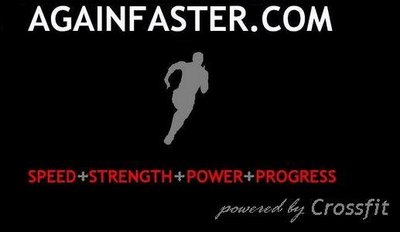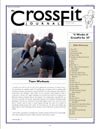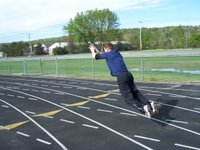A Hierarchy of Functional Movement
One of the basic tenets of the CrossFit method is a reliance on functional movement. Simply, this means that movements with limited real-world application have no place in our programming.
For this reason, we eschew biceps curls, triceps kickbacks, leg extensions, and almost any movement that requires you to put your butt in contact with anything. These movements have little bearing on reality. When fate calls on you to sprint down the block, pick up a fallen pedestrian, and hump a mile to the emergency room, you’ll find that all the “arm days” in the world won’t make you equal to the task. On the other hand, a strong deadlift, a decent squat, and a large dose of metabolic capacity would let you pass this hero test with flying colors.
Those of us who’ve been thoroughly exposed to CrossFit have a strong intuitive concept of functional movement. We know it when we see it. Our reality-based acid test begins and ends with an instantaneous assessment. If a movement is quick, powerful, and performed over a long range of motion, it’s probably functional. If it’s slow, weak, and truncated, it’s probably not.
As useful as this black and white characterization of movement may be, it is entirely too limited to apply to serious athletic training. After all, most athletes begin their careers performing slow, weak movements over a limited range of motion. Only through years of coaching, practice, and hard training do they become quick and powerful. It would be unfair to assume that our beginners are engaging in non-functional movement simply because they’re slow or temporarily limited.
The evolution from beginner to athletic stud follows a predictable path—a hierarchy of functional movement. Here, I’m going to describe that the hierarchy, using the barbell movements as a framework for explanation. Barbell movements lend themselves to easy description, and serve as great examples of the progressions inherent in functional movement. Nonetheless, the concepts presented here are not limited to barbell exercises—with a little creativity, they can be applied to nearly any type of movement as a gauge of athletic progress.
On the first tier of functional movement, we find two example exercises: the press and the back squat. Both are full-body, multi-joint movements, criteria that must be satisfied before I’m willing to call anything “functional”. Further, they are performed while standing. This third criterion may or may not be necessary to call a movement “functional” (depending on the person you ask and their fondness for the bench press), but I lean toward its inclusion.
The press begins with the barbell resting across the front deltoids and the athlete’s hands just outside shoulder width. Using only the elbow and shoulder joints (and the attendant muscles, of course), the athlete presses the bar overhead to full lockout, followed by a return to starting position along the same path. This movement has several features salient to our discussion. It is performed slowly, it involves two comparatively minor joints, and it covers a small range of motion. These features place it at the bottom of our hierarchy. Taken together, they indicate relatively low power output, a measure that I put forth as the ultimate arbiter of functionality.
Power output is equal to force multiplied by distance divided by time. For the sake of a good visual, it looks like this:
Power = (Force x Distance)/Time
We know that the press is performed slowly, so time is a large number in our power equation. Conversely, distance is small, as the press only covers a few feet. Force is also small, as the muscles and joints employed in the movement are relatively small, compromising the amount of force that can be generated. When time is large and force and distance are small, the resulting power output is also small.
Contrast this with the back squat. Like the press, this movement is performed slowly and involves two joints. It covers a similar distance in a similar amount of time. Unlike the press, the joints involved—the hip and the knee—are prime movers. These are major joints surrounded by large muscles capable of moving tremendous amounts of weight.
This changes the dynamic of our power equation substantially. Because the muscles surrounding the hip and the knee have a large cross-section, they’re capable of generating a lot of force, substantially increasing power output when compared to the press. For this reason, the squat is more functional than the press, although it belongs to the same two-joint, slow-moving family. As a reality check, we squat and stand dozens of times every day, but we’re less often called upon to push heavy objects overhead. This colloquial check of “functionality” meshes nicely with our theoretical definition.
The second tier of the hierarchy brings the push press and the squat clean. Like our first tier movements, both are full-body multi-joint movements performed from standing. The push press is exactly like the press, except the movement is initiated with the hip and the knee rather than with the shoulder and the elbow. The athlete holds the barbell across the front deltoids, dipping and driving with the lower body. Momentum from this motion is transferred through the torso into the barbell, sending it skyward. As the barbell elevates, the athlete presses upward, locking out the bar overhead. Upon completion, the barbell is returned to the starting position.
Note the features of the push press: it is performed quickly and involves four joints—the hip, the knee, the shoulder, and the elbow. It also covers a slightly larger distance than the press. Referring back to the power equation, we see that these factors indicate a higher power output than the press—time is reduced, and force and distance are increased. Therefore, the push press is theoretically more functional than its first-tier cousin. Again, a quick reality test confirms our findings: a movement that allows you to boost comparatively more weight overhead is certainly more useful in day-to–day life than its less-loaded counterpart.
Like the push press, the squat clean is a quick movement involving four joints. The barbell starts on the floor with the athlete in a quasi-crouch behind it, hands just outside shoulder width. The athlete deadlifts the bar to mid-thigh and explodes violently upward, simultaneously extending the knees and hips while shrugging the shoulders. She then pulls under the barbell, landing in a full squat with the bar racked across the shoulders, and returns to standing.
The squat clean covers a large distance very quickly. The bar moves from the ground to shoulder height in scarcely more time than it takes to complete a push press, and the dynamic nature of the movement allows the athlete to lift absurdly large loads. This combination of speed, distance, and load indicates a very high power output and a correspondingly high degree of functionality. The real life utility of the movement supports this contention—the squat clean allows otherwise unmanageable loads to be shouldered and carried, a benefit with nearly limitless applications.
The third and final tier of our hierarchy represents the highest level of functional movement, containing the snatch and the clean and jerk. Like the preceding exercises, these are full-body, multi-joint movements performed from standing. They take the critical traits of the second tier exercises—quickness, load, and range of motion—and push them to the limits of human capability. Each uses the hip and knee to transfer the load to the shoulder and elbow, and moves the barbell through the entire range of motion available to the athlete.
The snatch is very similar to the squat clean, but the barbell does not stop at the shoulders. Instead, it is brought overhead in one swift movement. Taking a wide grip, the athlete deadlifts the bar to hip height, explodes upward, and pulls herself under, catching the bar in the bottom position of the overhead squat. She then returns to standing with the bar overhead.
The speed of the movement is comparable to that of the squat clean, but the barbell covers a much larger distance. The load lifted is smaller, amounting to 70-80% of that of the squat clean. Greater distance and lesser load combine to put the snatch on par or slightly ahead of the squat clean in terms of power output, indicating greater or equal theoretical functionality according to our hierarchy. A quick reality check throws this finding into doubt—would anyone snatch something from the ground to overhead when given an alternative? An examination of the final movement in the hierarchy, the clean and jerk, answers this question with a resounding “No!”
The clean and jerk begins with a squat clean, bringing the barbell from the floor to the shoulders. The athlete then pauses before launching the bar upward using a dip and drive. As the bar travels vertically, the feet are split fore and aft, and the athlete pushes under the barbell, catching it at arms’ length overhead. The athlete then recovers, bringing the feet side-by-side with the barbell at full extension.
The clean and jerk is slower than the snatch due to the mid-movement pause. Taken out of context, this might indicate a lower power output for the former movement. In actuality, the pause allows the athlete to handle a much larger load, overcoming the power-robbing effect of the delay. The effect of the larger load, combined with the fact that the barbell travels further due to the shoulder width grip, results in a higher overall power output than the snatch and indicates higher theoretical functionality. Using a reality-based definition, the functionality of the clean and jerk is undeniable. It allows an athlete to take a tremendous load—as much as three times bodyweight—and boost it overhead. Again, the applications are only as limited as your imagination.
Throughout the hierarchy, I’ve been hammering three core concepts: speed, load, and range of motion. In general, high-speed movements performed under heavy loads over a complete range of motion represent the apex of functionality, and should be held up as the end goal of athletic development. Getting to this point requires a measured progression through the hierarchy, gradually increasing speed, load, and range of motion according to the readiness of the individual athlete. Exercises should always be chosen that maximize these variables—multi-joint over single-joint, large joint over small joint, fast over slow.
CrossFit has taken most of the guesswork out of proper exercise selection. Indeed, “functional movement” is a watchword within the programming, and the majority of our exercises exhibit qualities indicative of high power output. Not surprisingly, these movements are easily transferable from the gym to the street, passing our final test of functionality. It isn’t hard to imagine a scenario in which ability to lift, throw, run, climb, and jump powerfully might be desirable or even necessary. In fact, some of CrossFit’s most demanding adherents live this reality every day. They pass the hero test regularly,
serving as living proof that non-functional movement has no place in a results-driven program.
EC Synkowski of CrossFit Boston drives under a split jerk.
























